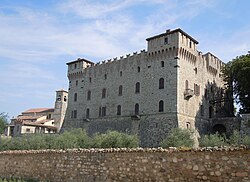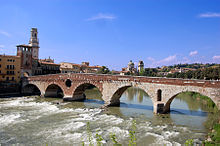| Morainic hills of Lake Garda | |
 | |
| Itinerary type | Automotive |
|---|---|
| State | Italy |
| Region | Lombardy is Veneto |
| Start | Lonato del Garda |
| end | Sona |
| Tourism site | |

Morainic hills of Lake Garda
Morainic hills of Lake Garda it is an itinerary that takes place through Lombardy is Veneto.
Introduction
The itinerary runs through the places that are inserted in the morainic hills that surround the Lake Garda, gone down in history for having been the scene of the bloody battles Risorgimento. In this area the "wines of the hills", tokai, merlot and claret are produced.
How to get
By plane
The nearest airports are:
- Bergamo-Orio al Serio Airport
- Brescia-Montichiari Airport. Charter only.
- Verona-Villafranca Airport
By car
The closest motorway exits are:
 Serenissima motorway: exit Desenzano del Garda, then direction Lonato del Garda; or toll booth of Sirmione, then direction Pozzolengo is Solferino
Serenissima motorway: exit Desenzano del Garda, then direction Lonato del Garda; or toll booth of Sirmione, then direction Pozzolengo is Solferino Brenner motorway: exit Mantua north, then direction Brescia, Guide it, Castiglione delle Stiviere
Brenner motorway: exit Mantua north, then direction Brescia, Guide it, Castiglione delle Stiviere
On the train
The nearest stations are:
- Desenzano del Garda railway station. Served by Frecciabianca for Milano Centrale, Torino Porta Susa, Trieste Centrale and Venezia Santa Lucia; from Frecciarossa to Brescia and Roma Termini and from regional to Milano Centrale and Verona Porta Nuova.
Stages
- 1 Lonato del Garda - Ancient city in province of Brescia which underwent several dominations during its history and was a strategic place being at the mouth of the Valtenesi. Among the most important monuments are the Visconti fortress, the basilica of San Giovanni Battista, the Abbey of Maguzzano, the church of the Madonna della Scoperta and the castle of Drugolo.

Castiglione delle Stiviere, Basilica of San Luigi

San Martino della Battaglia, tower

Castle of Monzambano
- 2 Castiglione delle Stiviere - The city of San Luigi Gonzaga, in province of Mantua, which is 10 km away. from Lonato, it was the capital, before the marquisate and then the principality, of the cadet line of the "Gonzaga di Castiglione", the longest-lived of the extinct lines of the family, started by Ferrante Gonzaga in 1559. It preserves important monuments of the time, such as the Basilica of San Luigi Gonzaga, the Gonzaga castle, the Collegio delle Vergini di Gesù, piazza Dallò and the Palazzo del Principe, the Red Cross Museum.
From Castiglione it is possible to take another itinerary called In the lands of the Gonzaga, to discover the capitals of the Gonzaga states. - 3 Solferino - It is located 7 km. from Castiglione and was the capital of the cadet branch of the "Gonzaga di Solferino", begun by Orazio Gonzaga in 1549. Of the Gonzaga period remains the Rocca (known as the "Spy of Italy"), the castle with its square, the memorial of the Croce Rossa and the Museum of the Risorgimento. The locality is also famous because the bloody was fought here battle of Solferino of June 24, 1859.
- 4 Cavriana - About 8 km. from Solferino, Cavriana was one of the oldest fiefdoms of the Gonzagas. In 1797 it was the seat of the Austrian headquarters and in 1859 Napoleon III resided here after the battle of Solferino. The most important monuments are the Romanesque Pieve, the fortress of the castle, Villa Mirra in which Isabella d'Este lived.
- 5 Volta Mantovana - 7 km away. from Cavriana, Volta Mantovana was part of the possessions of the Countess Matilde di Canossa. In the 15th century it became a vacation spot for the lords of Mantua, who built a villa with a garden here (Palazzo Gonzaga Guerrieri). Among the historical buildings we remember the castle tower and the church of Santa Maria Maddalena, in which the blessed Paola Montaldi rests.

Villafranca of Verona, villa Gandini, hall of the signing of the peace treaty
- 6 Castellaro Lagusello - 8 km. separate Volta Mantovana from Castellaro Lagusello, one of the most beautiful villages in Italy and World Heritage. The zone is inserted in the protected area of the Nature reserve Moraine complex of Castellaro Lagusello is in the Mincio Regional Park. Inside the village there are the tower of the ancient castle and Villa Arrighi, which hosted Napoleon in 1796.
- 7 Pozzolengo - 5 km. from Castellaro Lagusello we find Pozzolengo, in province of Brescia, inserted in the Lugana wine-growing area. Of historical importance is the ancient fortified village with the castle dating back to the 10th century.
- 8 San Martino della Battaglia - San Martino della Battaglia is about 5 km away. from Pozzolengo. Location where the historic battle of the second war of independence was fought on 24 June 1859, in which the forces of the Kingdom of Sardinia, led by Vittorio Emanuele II, allied with the French, defeated the Austrians, led by the Emperor Franz Joseph. To visit the Tower, a national monument and the Ossuary, which collects the remains of the combatants of the battle.
Point 8 - Deviation from the main itinerary
Lake Garda
From San Martino della Battaglia about 7 km.
- 9 Sirmione - Important tourist resort both for the presence of Roman and medieval remains and for the thermal waters. The Scaligero castle, the Catullus caves and the Romanesque church of San Pietro in Mavino are worth a visit.
From point 10 to point 16
- 10 Bridges over the Mincio - 10 km. they separate San Martino della Battaglia from Ponti sul Mincio, in the province of Mantua. Its name derives from the fact that the town once stood near a bridge over the Mincio. To see the ancient castle and the remains of the walls. In this area the "wines of the hills", tokai, merlot and claret are produced.
- 11 Monzambano - It rises in a pleasant position at 4 km. about from Ponti sul Mincio, on the right bank of the Mincio. It is dominated by the ancient 12th century castle, still surrounded by walls and four towers. In the locality of Olfino there is the sanctuary of the Trinity, of Romanesque origin.

Verona, Ponte Pietra
- 12 Valeggio sul Mincio - 3 km. separate Borghetto from Valeggio sul Mincio, a historic town in the morainic hills. On site there are the Scaliger fortifications of the castle, which belonged to the defensive line of the Seraglio. He visits the Sigurtà villa with its spectacular garden park and the Visconti bridge. The locality is known for its typical dish called "tortellini di Valeggio sul Mincio", egg pasta stuffed with meat.
- 13 Borghetto (Valeggio sul Mincio) - 7 km. from Monzambano we find Borghetto, a very popular locality in province of Verona, inserted among the most beautiful villages in Italy. Of ancient origins, it rises in the Mincio valley. To see the ruins of the Visconti bridge, from which it is possible to observe the village that rises on the river.
- 14 Custoza - 8 km. about from Ponti sul Mincio rises Custoza, which was the scene of two important battles of the Risorgimento, which in both cases saw the defeat of the Piedmontese army first (1848) and then Italian (1866) by the Austrian Empire. On the top of a hill stands the Ossuary which houses the remains of fallen soldiers. It is the production area of the DOC "bianco di Custoza" wine.
Point 14 - Deviation from the main itinerary
- 15 Villafranca of Verona - 7 km. from Custoza rises Villafranca, an important industrial center, with the airport of Verona-Villafranca. To visit Villa Gandini, where the armistice of 1859 was stipulated by Francesco Giuseppe, emperor of Austria and Napoleon III, emperor of France, the Scaliger castle and the Museum of the Risorgimento.
- 16 Verona - Famous for being the city of Romeo and Juliet, it was the capital of the Scaligeri and was declared by UNESCO World Heritage. It preserves notable historical testimonies and important architectures; among these the Roman Theater, the Arena, the Basilica of San Zeno, Piazza delle Erbe.
- 17 Sona - It is located about 5 km. from Sommacampagna, on the last offshoots of the morainic hills. It preserves important historical evidence of prehistory and Roman times. It was fortified by the Scaligeri who considered it of strategic importance for their territory. The area is dotted with stately villas built from the fourteenth to the nineteenth century.
Safety
Around
Excursions
Itineraries
- In the lands of the Gonzaga - An itinerary through the centers, large and small, which were the capitals of the Gonzaga cadet branches: principalities, marquisates, duchies which, within the Mantuan state structure, enjoyed real independence, often minted coins and held refined courts that rivaled that of Mantua, embellished their urban centers by equipping them with elegant architecture - churches, squares, palaces, walls, towers - and characteristic urban views such as the typical Gonzaga arcades.
- Walled cities of Veneto. An itinerary to discover the strongholds and the history of Veneto.
- Rural churches and oratories of Castel Goffredo - The itinerary, entirely in the green countryside rich in waterways, runs through the numerous places of worship, which boast ancient traditions and are the sign of a widespread religiosity, since the sixteenth century.
- Way of faith and solidarity - The itinerary runs through the places where two saints lived, St. Luigi Gonzaga is Saint Angela Merici, and a blessed one, Paola Montaldi; where important pages of the Risorgimento and saw the birth of the Red Cross.
- Via Carolingia - European itinerary that crosses the places traveled by the court of Charlemagne between the 8th and 9th centuries to travel from Aachen to Rome, where Pope Leo III crowned the Carolingian sovereign emperor of the Holy Roman Empire on Christmas night in the 19th century.



